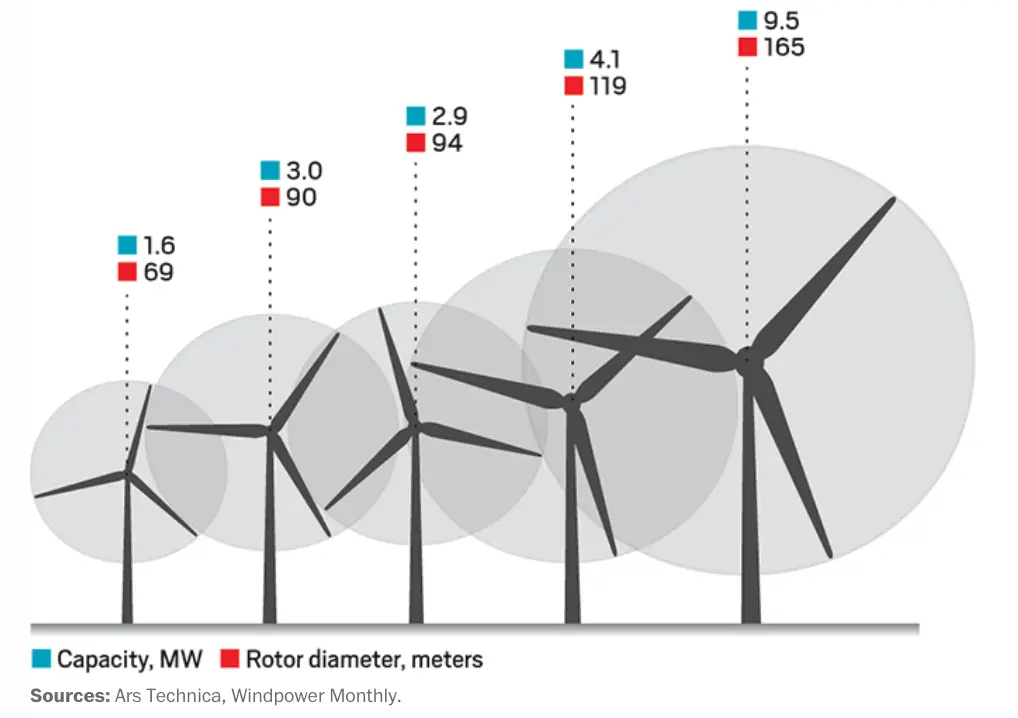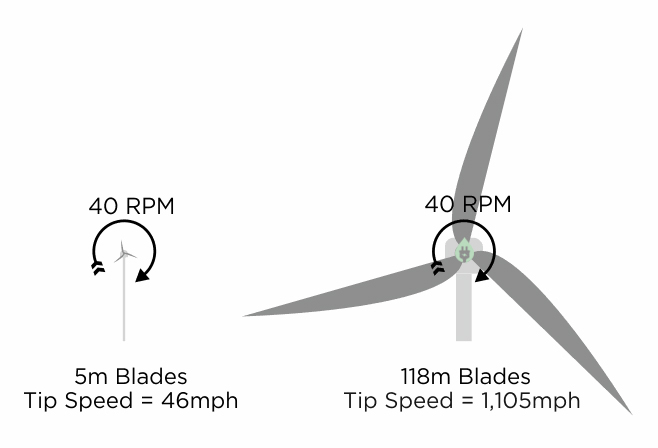Wind turbines generate power through the difference in air pressure across the sides of the blade, creating lift and drag forces. When the lift force is greater than the drag, the wind turbine spins the rotor and generates electricity.
Thus, the larger the blade, the more powerful and efficient the turbine – representing an economy of scale with bigger equaling better. By doubling the blade length, the power capacity (amount of power it actually produces versus its potential) increases four-fold without having to add more height to the tower [1].

Wind Turbine Blade Length
Forty years ago, wind turbine blades were only 26 feet long and made of fiberglass and resin [3]. Today, blades can be 351 feet, longer than the height of the Statue of Liberty, and produce 15,000 kW of power. Modern blades are made from carbon-fiber and can withstand more stress due to higher strength properties. They also make less noise due to aerodynamic improvements to the blade tip design.
The largest and most powerful wind turbine in the world is Siemens Gamesa SG 14-222 DD prototype for offshore wind turbine which is being tested in Denmark [4]. With a capacity of 15 MW and 222-meter rotor, this can power 18,000 European homes per year.
The swept area is 39,000 m2 (translating to a larger volume of air and more mass to move) with each blade being 108 meters (354 feet). This is about the length of an entire football field or 1.5 times the wingspan of a Boeing 747 jet; This flagship model is scheduled to be commercially available in 2024 with an install date later this year in 2022.
Since 2009, the average swept area of wind turbines has doubled with the length of blades increasing 20 percent [5]. Larger swept area captures more wind and requires the blades to be more flexible to bend and deflect.
Why Has Turbine Blade Length Doubled?
Longer blades create more efficient turbines; however, they also put more mechanical stress on the structure, so it requires lighter materials and improved design.
Wind turbine blades have doubled in size since the 1980s due to improvements in the fabrication method [2].
By using polyurethane, blades can require 10% less material than epoxy resulting in lighter blades that require less powerful wind to rotate. Polyurethane’s mechanical and fatigue properties are superior to epoxy allowing for easier production of long wind turbine blades. Polyurethane is also cheaper which is crucial to driving down the levelized cost of energy (LCOE) as blades represent 30% of the wind turbine’s total cost due to complicated composite molds.
By having larger wind turbine blades, this translates to smaller wind farms that take up less space with more powerful wind turbines [1]. It is also more cost efficient to have one very powerful wind turbine as opposed to three smaller wind turbines with less materials and maintenance. With less wind turbines overall, there will be less blades ending up in the landfill, thus making wind energy more sustainable.

There is no set ideal ratio for rotor diameter to tower height, but on average the rotor diameter is half the height of the tower. For offshore, the blades are more gigantic than onshore and tend to be more than half the tower height.
For example, the largest wind turbine in production (GE Haliade-X, 14 MW) has 107 meter blades that are 80% of its tower height. These blades are some of the largest components for a machine ever built. These large blades do not require high winds to move; in fact, its low rotational inertia keeps the momentum going even when the wind speed has dramatically reduced.
Is there a Theoretical Limit for Blade Length?
The limit to the maximum size of a wind turbine blade involves the point of inflection, when the blades begin to bend and flex.
Longer blades are more flexible which also creates more vibration, affecting the overall performance and reduces the life of not only the blades but also the attached gearbox [6].
Safety of operation is also a concern, especially during extreme weather events to prevent the blades from crashing into the tower or hub.
There is also the issue of transportation as the blades must be transported on ships, railways, and trucks that are limited by the radius of a turn they can make as well as the size of the roads, bridges, and tunnels they must cross under [7]. The blades also cannot be dismantled like some of the wind turbine’s other components.
Final Thoughts
Improved wind turbine blade design has allowed for higher production of energy at a much lower cost. Blades are now as long as an entire football field and made from lighter composite materials to put less stress on the structure.
While there is a maximum size that blades will reach due to physics and the amount of bend the structure can take, that limit has yet to be seen and will likely increase over the years with improved materials and engineering design.

